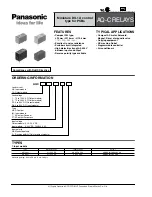
4
44
44
3.1.1 Analog input circuits
The analog input voltages are galvanically decoupled by
the input transformers of the device, then filtered and
finally fed to the analog digital converter. The measuring
circuits can be applied in star or delta connection (refer
to chapter 4.3.1).
3.1.2 Blocking input
The blocking function can be set according to
requirement. By applying the auxiliary voltage to D8/E8,
the previously set relay functions are blocked (refer to
4.8 and 5.7.1).
3.1.3 Reset input
Please refer to chapter 5.9.1
3.1.4 Output relays
The
MRN3
MRN3
MRN3
MRN3
MRN3
is equipped with 5 output relays. Apart from
the relay for self-supervision, all protective functions can
be optionally assigned :
z
Relay 1 : C1, D1, E1 and C2, D2, E2
z
Relay 2 : C3, D3, E3 and C4, D4, E4
z
Relay 3 : C5, D5, E5
z
Relay 4 : C6, D6, E6
z
Relay 5 : Signal self supervision (internal fault of the
unit) C7, D7, E7
All trip and alarm relays are working current relays, the
relay for self supervision is an idle current relay.
3.1.4 Output relays
The
MRN3
MRN3
MRN3
MRN3
MRN3
has a fault value recorder which records the
measured analog values as instantaneous values.
The instantaneous values
U
L1
; U
L2
; U
L3
; for star connection
or
U
12
; U
23
; U
21
for delta connection
are scanned at a raster of 1.25 ms (at 50 Hz) and
possible to store 1-8 fault occurences with a total
recording time of 16 s (with 50 Hz) and 13.33 s (with 60
Hz) per channel.
Fig. 3.1 : Connection diagram MRN3-1 and MRN3-2
Fig. 3.1 : Connection diagram MRN3-1 and MRN3-2
Fig. 3.1 : Connection diagram MRN3-1 and MRN3-2
Fig. 3.1 : Connection diagram MRN3-1 and MRN3-2
Fig. 3.1 : Connection diagram MRN3-1 and MRN3-2
Storage division
Independent of the recording time, the entire storage
capacity can be divided int0 several cases of disturbance
with a shorter recording time each. In addition, the
deletion behaviour of the fault recorder can be
influenced.
No writing over
If 2, 4 or 8 recordings are chosen, the complete memory
is divided into the relevant number of partial segments. If
this max. number of fault event has been exceeded, the
fault recorder block any further recordings in order to
prevent that the stored data are written over. After the
data have been read and deleted, the recorder to ready
again for further action.
Writing over
If 1, 3, or 7 recordings are chosen, the relevant number
of partial segments is reserved in the complete memory.
If the memory is full, a new recording will always write
over the oldest one.
The memory part of the fault recorder is designed as
circulating storage. In this example 7 fault records can be
stored (written over).
1
3
8
7
6
5
4
2
Fig. 3.2 : Division of the memory into 8 segments,
Fig. 3.2 : Division of the memory into 8 segments,
Fig. 3.2 : Division of the memory into 8 segments,
Fig. 3.2 : Division of the memory into 8 segments,
Fig. 3.2 : Division of the memory into 8 segments,
for example
for example
for example
for example
for example
Memory space 6 to 4 is occupied.
Memory space 5 is currently being written in
A7
A6
A4
tdt
tf</tf>
f<</f>>
f
f</f>
t
tf<</tf>>
tu<</tu>>
E8
D8
CB
Blocking
input
External
Reset
L3
L2
L1
A3
A5
Serial Interface
N
G
P
P
G
N
selfsupervision
Alarm
Relay 1
E2
C2
E1
C1
D2
D1
=
-
~
D9
E9
C9
L-/N
L+/L
t
U</U>
U
U<</U>>
TRIP
ENTER
-
+
SLECT/
REST
D4
D5
C4
E4
C5
E5
E6
C6
D6
D7
C7
E7
tu</tu>
a
A
B
b
c
C
Power
supply
A8
Relay 2
df
dt
Q
D
df
dt
t
Relay 3
Relay 4
3. Design
3.1 Connections





































